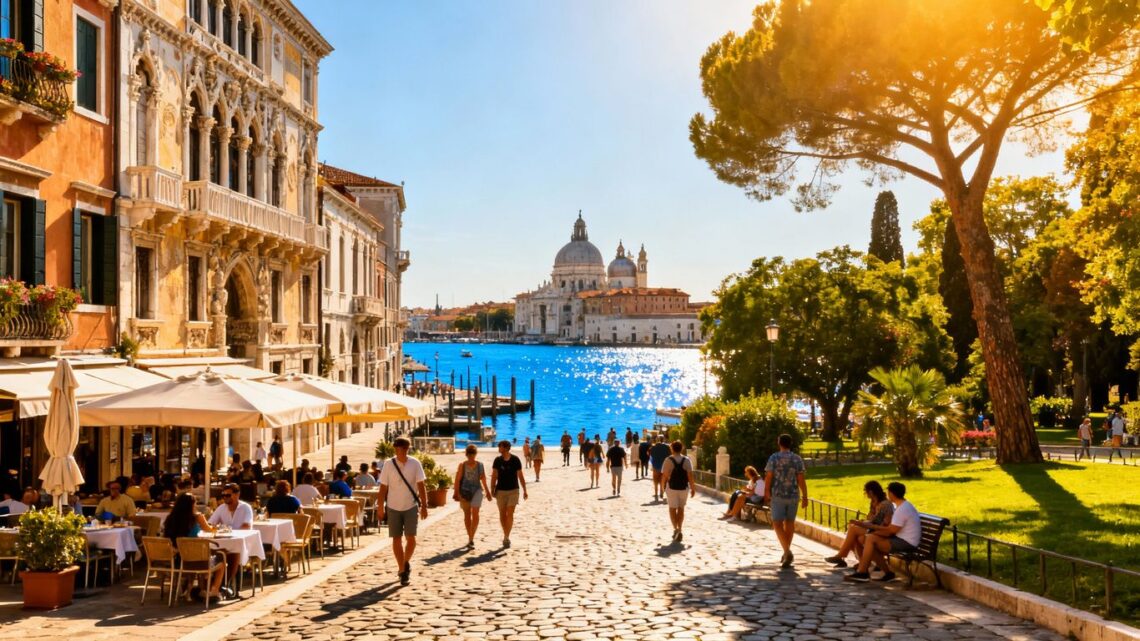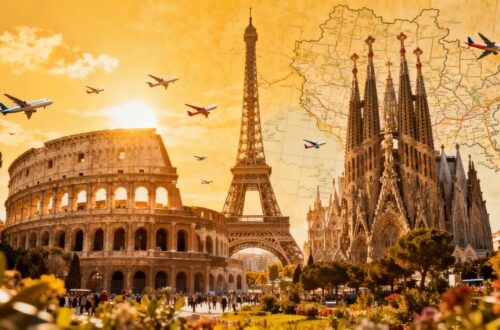Planning a trip for 2025? Europe is calling! With so many amazing places to see, figuring out where to go can be tough. We’ve put together some ideas for the best European holiday destinations to help you plan your dream getaway. Whether you love history, nature, or just good food, Europe has something for everyone. Let’s explore some fantastic spots that should definitely be on your radar for next year.
Key Takeaways
- Explore ancient history by visiting iconic sites like the Colosseum in Rome and the Acropolis in Athens.
- Experience natural wonders, from the magical Northern Lights in Iceland to island hopping in the sunny Mediterranean.
- Indulge in Europe’s famous food scene with experiences like savoring tapas in Seville or enjoying authentic Neapolitan pizza.
Discover Iconic European Landmarks

Europe is just packed with places that make you stop and stare. Seriously, you could spend weeks just hopping between cities and still only scratch the surface of all the history and art packed into this continent. It’s like stepping into a history book, but way more fun because there’s usually good food involved.
Planning a trip to see these famous spots means you’re in for some serious awe. Whether you’re a history buff or just someone who likes looking at really old, really impressive stuff, Europe delivers.
Explore the Ancient Wonders of Rome
Rome. Just saying the name conjures up images of gladiators and emperors, right? The Colosseum is the big one, of course. Standing inside that massive amphitheater, you can almost hear the roar of the crowds from two thousand years ago. It’s pretty wild to think about. But Rome is so much more than just the Colosseum. You’ve got the Roman Forum, which was basically the heart of ancient Roman life – think government buildings, temples, and marketplaces all in one sprawling area. And then there’s the Pantheon, with its incredible dome that still amazes architects today. It’s a place that feels both ancient and somehow still alive.
- Colosseum: Imagine the spectacles that happened here. It’s huge!
- Roman Forum: Walk where senators and citizens once gathered.
- Pantheon: Marvel at the engineering of its massive, unsupported dome.
Visiting Rome is like walking through a living museum. Every corner you turn, there’s another piece of history waiting to be discovered, from grand ruins to charming cobblestone streets.
Wander Through the Historic Acropolis of Athens
Athens is where democracy was born, and the Acropolis is its crown jewel. Perched high above the city, this ancient citadel is home to the Parthenon, a temple dedicated to the goddess Athena. Even in its ruined state, it’s incredibly beautiful and a symbol of classical Greece. Getting up there involves a bit of a climb, but the views over Athens are totally worth it. You can spend hours just exploring the different structures and imagining what life was like back then. The Acropolis Museum, located nearby, is also a must-visit to see artifacts found on the site up close.
- Parthenon: The iconic temple that dominates the Athenian skyline.
- Erechtheion: Known for its unique Caryatid porch with sculpted female figures.
- Propylaea: The monumental gateway to the Acropolis.
It’s easy to get lost in the sheer age of these places. You’re literally standing where people stood thousands of years ago, making decisions that shaped the world. It’s a pretty humbling experience, honestly.
Embrace Nature’s European Masterpieces

Europe isn’t just about old buildings and busy cities, you know? There’s a whole other side to it, full of incredible natural beauty that can really take your breath away. If you’re looking to connect with the wilder side of the continent, 2025 is a fantastic year to explore.
Seeing the Aurora Borealis is something else. It’s like the sky itself is putting on a show, with ribbons of green, purple, and sometimes even red dancing above you. It’s a pretty humbling experience, honestly. To get the best chance of seeing them, you’ll want to head north, away from any city lights. Places like Tromsø in Norway or Abisko in Sweden are popular for a reason. The colder and clearer the night, the better your chances. It’s not a guarantee, of course, but when it happens, it’s unforgettable.
Here’s a quick rundown of what to consider:
- Timing: Late autumn through early spring (roughly September to March) offers the longest, darkest nights.
- Location: Aim for areas within the Arctic Circle for the highest probability.
- Conditions: Clear skies are your best friend. Check the aurora forecast!
- Patience: Sometimes you have to wait, but it’s worth it.
The sheer scale and unpredictable nature of the Northern Lights make it a truly special event. It’s a reminder of how amazing our planet is.
If you’re more of a sun-and-sea person, the Mediterranean islands are calling your name. Think crystal-clear waters, charming villages, and food that tastes like sunshine. You could spend weeks just hopping from one island to another and still not see it all. Places like the Greek Cyclades offer that classic white-washed village vibe, while islands off the coast of Croatia have this rugged, historical feel with amazing coastlines.
Here’s a little taste of what island hopping can offer:
- Greece: Explore the iconic Santorini or Mykonos, or find quieter gems like Folegandros.
- Croatia: Sail between islands like Hvar, Korčula, and Brač, discovering hidden coves.
- Italy: Consider the Amalfi Coast islands like Capri or the Aeolian Islands for volcanic landscapes.
It’s a great way to see a lot of different places without the hassle of constantly packing and unpacking. You can find boat tours, rent your own small yacht, or even use ferries to get around. Plus, the seafood is usually incredible, fresh off the boat and served in little seaside restaurants. It’s pretty much the definition of a relaxing holiday.
Culinary Journeys Through Europe

Europe isn’t just about ancient ruins and stunning landscapes; it’s also a paradise for food lovers. From savory tapas to the most famous pizza in the world, your taste buds are in for a treat. Get ready to explore some of the continent’s most delicious offerings.
Savor Tapas in Seville
When you think of Seville, Spain, you might picture flamenco dancers and Moorish architecture, but the city is also a tapas capital. These small, flavorful dishes are perfect for sharing and trying a variety of local tastes. Think patatas bravas (fried potatoes with spicy sauce), gambas al ajillo (garlic shrimp), and jamón ibérico (Iberian ham).
It’s a fantastic way to experience the local culture, one bite at a time.
Here’s a little guide to enjoying tapas like a local:
- Go bar hopping: Don’t stick to one place. Move from bar to bar, trying a tapa or two at each.
- Order a drink: Tapas are almost always enjoyed with a drink, like a local wine, sherry, or a refreshing tinto de verano (red wine with lemon soda).
- Embrace the chaos: Tapas bars can get crowded and noisy, but that’s part of the fun. Just go with the flow.
Indulge in Neapolitan Pizza
No trip to Europe is complete without tasting authentic Neapolitan pizza, straight from its birthplace in Naples, Italy. This isn’t just any pizza; it’s a culinary art form with a protected status. The dough is soft and chewy, the tomato sauce is bright and fresh, and the mozzarella di bufala is creamy and rich.
The key to true Neapolitan pizza lies in its simplicity and the quality of its ingredients. Cooked quickly in a wood-fired oven at very high temperatures, it results in a slightly charred, wonderfully tender crust.
When in Naples, look for pizzerias that adhere to the traditional methods. The two classic options you absolutely must try are:
- Pizza Margherita: Simple yet perfect, with tomato, mozzarella, fresh basil, and olive oil.
- Pizza Marinara: Even simpler, featuring tomato, garlic, oregano, and olive oil – a testament to how few ingredients can create incredible flavor.
Ready to Pack Your Bags?
So, we’ve looked at some pretty amazing spots in Europe for 2025, from the sunny shores of the Mediterranean to the dramatic landscapes of the Alps. It’s clear Europe has something for everyone, whether you’re after history, food, adventure, or just a good dose of relaxation. Picking just one place can be tough, right? But that’s the beauty of it – Europe is so diverse, you could visit a different country every year and still have more to see. Start dreaming, do a little research, and get ready for a trip you won’t forget. Your next big adventure is waiting!
Frequently Asked Questions
What’s the best time of year to visit Europe?
Europe is awesome all year round! If you love warm weather and beaches, summer (June to August) is perfect. For blooming flowers and cooler temps, spring (March-April) is lovely. Winter (December-February) is great for skiing and seeing the Northern Lights, plus there are fewer crowds. Fall (October) offers beautiful colors and fewer people too.
Do I need a visa to travel in Europe?
It really depends on where you’re from and which European countries you plan to visit. Many countries are part of the Schengen Agreement, and if you’re from certain places, you might not need a visa. It’s always a good idea to check the official government websites for the countries you’re visiting to be sure about visa rules.
What should I pack for a trip to Europe?
Comfortable shoes are a must because you’ll be doing a lot of walking! Pack layers, like a light jacket, because the weather can change. For summer, bring light and breezy clothes. If you’re traveling in winter, you’ll need warm jackets and layers to stay cozy. Don’t forget a bag to keep your stuff handy.






